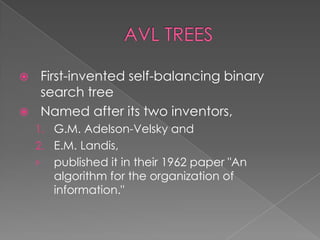Avl trees
- 2. ï First-invented self-balancing binary search tree ï Named after its two inventors, 1. G.M. Adelson-Velsky and 2. E.M. Landis, âš published it in their 1962 paper "An algorithm for the organization of information."
- 3. ï First, its a binary search tree... ï L <= P and P <= R RL P
- 4. ï Is this a binary tree search tree? 3 9 5 15 21 17 28 34 32 43 51 46 52 54 53 58 68 60 71 79 7712 35 56 29 70 50
- 5. ï An AVL tree is a balanced binary tree ï To understand balance we need to understand the notion of Tree Height 55 32 71 64 86 Height 0 Height 1 Height 2
- 6. ï By default, nodes with no children have a height of Height of 0. 55 32 71 64 86 Height 0 Height 1 Height 2 Height 0 Height 0
- 7. ï But, we must also understand the concept of Sub-trees 55 32 71 64 86 Height 0 Height 1 Height 2 Height 0 Height 0 sub-tree L has a height of 0 sub-tree R has a height of 1 Height = max(L.height, R.height) + 1
- 8. ï Also empty sub-trees have a Height of -1 44 58 91 Height = 2 = max(0, 1) + 1 Height = 0 = max(-1,-1) + 1 Height = max(L.height, R.height) + 1 Height = 1 = max(-1, 0) + 1
- 9. ï Anyway, the AVL Balance Property is as follows... ï For ALL nodes, the Height of the Left and Right Sub-trees can only differ by 1. P A Node L R 1.. heightRheightL
- 10. 1. After every insertion 2. Check to see if an imbalance was created. âĒ All you have to do backtrack up the tree 3. If you find an imbalance, correct it. 4. As long as the original tree is an AVL tree, there are only 4 types of imbalances that can occur.
- 11. ï Left-Left (Single Rotation) ï Right-Right(Single Rotation) ï Left-Right (Double Rotation) ï Right-Left(Double Rotation)
- 12. Single rotation: insert 14, 15, 16, 13, 12, 11, 10 14 15 âĒ First insert 14 and 15: âĒ Now insert 16.
- 13. Single rotations: 14 15 âĒ Inserting 16 causes AVL violation: âĒ Need to rotate. 16
- 14. Single rotations: 14 15 âĒ Rotation type: 16
- 15. Single rotations: 14 15 âĒ Rotation restores AVL balance: 16
- 16. Single rotations: 14 15 16 âĒ Now insert 13 and 12: 13 12 âĒ AVL violation - need to rotate.
- 17. Single rotations: âĒ Rotation type: 14 15 16 13 12
- 18. Single rotations: 13 15 16 âĒ Now insert 11. 12 14
- 19. Single rotations: 13 15 16 âĒ AVL violation â need to rotate 12 14 11
- 20. Single rotations: âĒ Rotation type: 13 15 16 12 14 11
- 21. Single rotations: 13 15 16 12 1411 âĒ Now insert 10.
- 22. Single rotations: 13 15 16 12 1411 10 âĒ AVL violation â need to rotate
- 24. Single rotations: 13 15 16 11 1410 12 âĒ AVL balance restored.
- 25. Double rotations: insert 1, 2, 3, 4, 5, 7, 6, 9, 8 âĒ First insert 1 and 2: 13 15 16 11 1410 12
- 26. Double rotations: 13 15 16 11 1410 âĒ AVL violation - rotate 1 2 12
- 27. Double rotations: 13 15 16 11 1410 âĒ Rotation type: 1 2 12
- 28. Double rotations: âĒ Now insert 3. âĒ AVL balance restored: 1 10 13 15 16 11 142 12
- 29. Double rotations: âĒ AVL violation â rotate: 1 10 13 15 16 11 142 12 3 12
- 30. Double rotations: âĒ Rotation type: 1 10 13 15 16 11 142 12 3
- 31. Double rotations: âĒ AVL balance restored: 1 3 13 15 16 10 142 11 12 âĒ Now insert 4.
- 32. Double rotations: âĒ AVL violation - rotate 1 3 13 15 16 10 142 11 12 4
- 33. Double rotations: âĒ Rotation type: 1 3 13 15 16 10 142 11 12 4
- 34. Double rotations: 10 13 15 2 111 3 4 12 14 16 âĒ Now insert 5.
- 35. Double rotations: 10 13 15 2 111 3 4 12 14 16 âĒ AVL violation â rotate. 5
- 36. Single rotations: 10 13 15 2 111 3 4 12 14 16 5 âĒ Rotation type:
- 37. Single rotations: 10 13 15 2 111 4 5 12 14 16 3 âĒ AVL violation â rotate. 7
- 38. Single rotations: 10 13 15 2 111 4 5 12 14 16 3 7 âĒ Rotation type:
- 39. Double rotations: 10 13 15 4 112 5 7 12 14 16 31 âĒ AVL violation - rotate. 6
- 40. Double rotations: 10 13 15 4 112 5 7 12 14 16 31 âĒ Rotation type: 6
- 41. Double rotations: 10 13 15 4 112 6 7 12 14 16 31 âĒ AVL balance restored. âĒ Now insert 9 and 8. 5
- 42. Double rotations: 10 13 15 4 112 6 7 12 14 16 31 âĒ Rotation type: 9 8 5
- 43. Final tree: 10 13 15 4 112 6 8 12 14 16 31 âĒ Tree is almost perfectly balanced 5 97











































